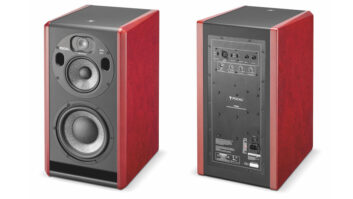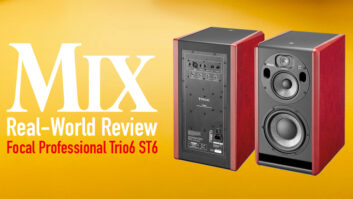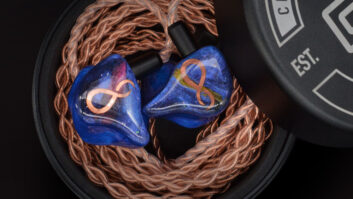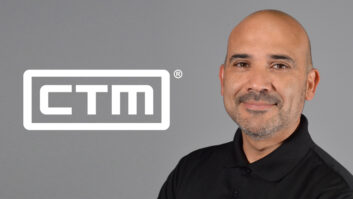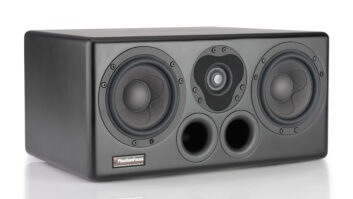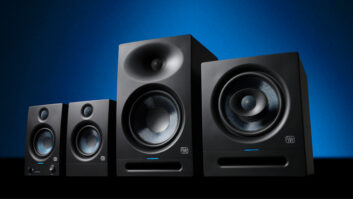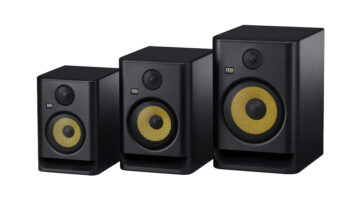Having seen them at several industry shows, I’ve admired the Focal SM Series’ look and sound for a while now and looked forward to giving them a serious test-drive. The SM8 is a self-powered bi-amped speaker (sold in pairs) weighing a solid 33 pounds. A 100-watt, Class-A/B amplifier drives the tweeter — a Beryllium inverted dome — while a separate 200W Class-D amplifier drives the 8-inch W-cone woofer.
Overall stated frequency response is 45 to 40k Hz, ±2 dB, and maximum SPL is rated at 115dB SPL (peak @ 1m). A passive 8-inch radiator on the top of the cabinet helps deliver more low end and helps smoothly dissipate some of the energy below 40 to 50 Hz. A subwoofer is recommended; no matter how well the SM8 handles LF content, there’s still a decided lack of punch in the low end, just as expected with any 8-inch system such as this.
BEST OF BOTH WORLDS
Input is on analog (XLR) or AES digital inputs (also XLR), both plainly marked. An optional wired remote controls level, dim and mute functions, operating via a serial RS-232 port. Tandem control of the second box is carried out via MIDI. Either speaker can function as the master/slave in digital mode by selecting the appropriate setting on the AES channel selection switch. (A very handy AES L/R splitter box is also supplied with the system; one cable in and two L/R outs make digital connections a snap.)
The real fun begins when you load the Focal Manager software into your PC, Mac or Palm/PDA. (The PDA option uses the infrared option switch.) Software installation is simple and straightforward: Load the executable file on the CD-ROM with either your PC or Mac and connect the RS-232 serial cable. Once the software is installed, each speaker is identified by its own serial number so that Focal Manager then knows which speaker it is controlling.
CONTROL YOURSELF
Focal Manager allows control of output level, shelving EQ, general EQ, assorted presets and delays for either speaker independent of each other (allowing for 2.1 or 5.1 setups, along with subwoofer management settings). A user-customizable section gets you quickly up and running, with easily viewed color scheme when changing parameters. A Bypass button allows A/B comparisons of settings and storable settings once you’ve found what you want. There is also a very useful utilities section and a password function.
Some of the important features of the software include the use of FIR equalization. (Finally, digital EQ right where you want it — at the amp driving the speaker!) Sometimes, even a little was a lot when I changed settings to experience a few wildly different response curves. The possibilities seem limitless for tuning these speakers to most work areas, be it a small project studio or a larger production suite.
The second notable feature is the ability to control and fine-tune the “sweet spot” for 2.1 and 5.1 speaker settings via the Delay sub-menu of the software controls. Dial in the distances of your speakers (L, C, R, Ls, Rs), and the software does the rest based on your choice of sitting position relative to the speakers and listener height.
POWERED UP AND RUNNING
When I used them as part of my video editing and MIDI keyboard production suite, I found a lot to like about the sound and imaging of these speakers. For rock, jazz and pop work, they really delivered the kind of smooth mid to low end I prefer, without exaggeration or boominess, and lot of clean power. The smooth, silky top end really opened up the sound of most keyboard and guitar parts. I found new depth and dimension to many piano parts I created. and the stereo imaging was thrilling: rock-solid. It was often difficult to tell they were on; they’re very quiet with little system noise, and they never got warm or hot to the touch, even on the back surfaces where the controls and amps are located.
For mixing soundtracks, dialog, videogames and other projects where imaging and localization are highly critical, the SM8s really shine. I did some A/B tests of a few recent live projects and found new depth and colors in some mixes we’d otherwise missed.
I got a chance to give them a serious workout while mixing a recent NPR program for WRTI-FM here in Philadelphia. The program — Mellon Jazz’s “One Nation Under Jazz” live broadcast series — featured Chicago saxophonist Von Freeman and his band. Before getting started, I needed a good reference point, and the DSP software let me make various tweaks to the system’s response curve as needed, getting both test signals and my favorite recordings sounding as they should.
The Sweet Spot software controller works with the Delay function for tweaking the soundstage.
The software is straightforward and intuitive, but in case you don’t trust your ears or fatigue sets in, you can always return to the factory default mode and start over, or set up various curves and toggle among all the choices. Finding a few minor dead spots and resonances in my mix area (nothing serious), a quick tweak of the Focal Manager software let me address the bumps and dips and quickly move on. (You can, of course, get creative and save settings of your own, depending on the task and genre at hand: tracking, mastering, pop, rock, metal, ska, classical, etc.)
Now sure of what I was hearing, I dug in and had some fun, taking my time with the broadcast mix and editing. With the SM8s, it was easy to re-create the soundstage just as I’d originally heard it in the hall. I tend to prefer the sound of an all-acoustic jazz trio anyway, and getting to hear my mixes on the SM8s put it all in perspective.
As stated earlier, without a sub, the SM8s are a little light on the low end (below 80 to 100 Hz and down), but nothing that took me too far from what I wanted. Acoustic bass, kick drum and other low components played nicely together, and the mix translated well to my sub-equipped Lipinski L-505 system. The 8-inch passive radiator on the top seems to act as a gentle shock absorber, as well as a radiator for low-end material. This is helpful, as with many other monitor systems in this size group, no sub can mean overcompensation and too much low end.
THE ENVELOPE, PLEASE
I found one downside regarding the SM8s’ Beryllium tweeter. The speakers come with a sticker warning you not to touch or even get near the tweeter if it’s damaged or broken open. The manufacturer advises covering it up with the supplied caps and sending it back to them.
However, these speakers are just loaded with features and options. Whether you’re running straight out of a digital console (at various sample rates; i.e., 44, 48, 88 or 96k) or balanced analog, you have a wide range of options for control and accurate tailoring of your sound. The software-driven EQ and time-align capabilities let you customize your sonic environment entirely inside the box.
At an MSRP of $5,598, the SM8s are worth the investment and could be the last system you’ll buy for a long time.
Focal (www.focalprofessional.com), dist. by Wave Distribution, 973/728-2425, www.wavedistribution.com.
Joe Hannigan runs Weston Sound & Video in Philadelphia.
